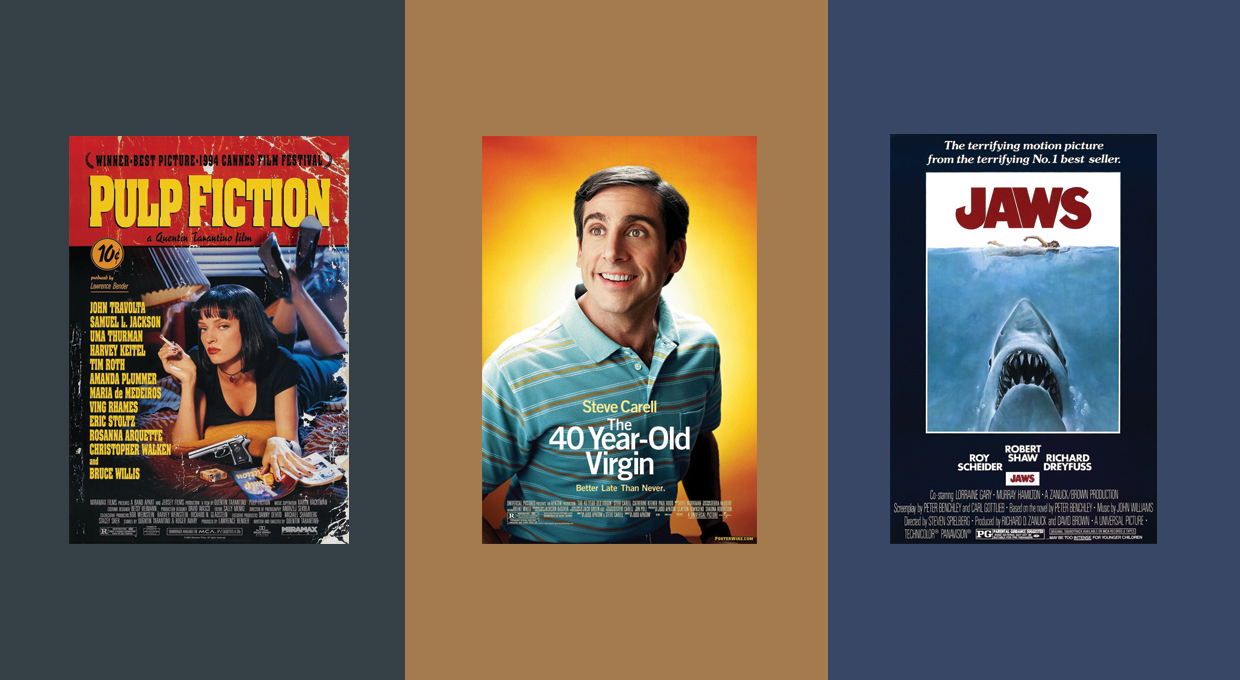
The movie poster is a 27 inch by 41 inch canvas used to sell a potential viewer with eye-popping visuals, big names, and catchy slogans.
Unsurprisingly, though, the stylings and practices of movie posters have changed substantially through the years. They aren’t all made equal, but the best have stood the test of time to become legendary images ripe for t-shirts and the dormitory walls.
Cinématographe Lumière from 1886 is thought to be the original movie poster advertising the world’s first public movie screening. Thirty people reportedly attended the 20-minute event at a random Parisian café—not exactly a red-carpet premiere.
The rise of movie posters, as we’ve come to know them, coincided with the film-industry boom beginning in the mid-1920s. Films became a business in this era, with increasingly ambitious silent films birthing Hollywood and the first so-called ‘movie stars.’
Posters from this time are what you might expect: bright colours, atlas font, men dressed in suits, and romanticized women. Classic, but outdated.
Things somewhat improved in the 1930s with the release of landmark films such as Gone with the Wind, The Wizard of Oz, and the original King Kong. While not quite on the same level as what came later, these posters are more detailed and professional.
Into the 1940s and 1950s, it became quite common for movie posters to feature the ‘man and woman kissing’ cliché. However, in the 1960s, Hollywood produced some legendary flicks with iconic posters like The Good, the Bad, and the Ugly, The Sound of Music, 2001: A Space Odyssey, and Breakfast at Tiffany’s, to name a few.
Then in 1975, we got Jaws.
This iconic image for Steven Spielberg’s horror masterpiece—which depicts a giant great white shark lurking in the water below an unassuming swimmer—remains instantly recognizable almost fifty years after the film’s theatrical release.
Jaws set the benchmark for everything that followed. It was the killing bite for the tame, old-timey posters already on their way out of Hollywood.
Just two years later, Star Wars arrived in all its glory.
The film needs no introduction. You know the story of Luke Skywalker and friends, illustrated brilliantly on the film’s promotional poster. The art is flashy, exciting, and the format has remained relatively unchanged for its countless sequels and spin-offs.
From Scarface to Ghostbusters, movie posters had reached another level by the 1980s. Their images became integral pieces of pop culture, and this trend continued into the 1990s with the likes of Uma Thurman posing for Pulp Fiction and Jurassic Park’s dinosaur.
Unfortunately, many of these world-famous posters set the bar so high that Hollywood artists have struggled to reach similar heights in the last two decades.
The 2000s birthed some classics that have adorned fans’ walls since their releases—Kill Bill, The 40-Year-Old Virgin, and The Dark Knight—but, overall, the industry has seen a noted decline in truly memorable movie posters since the turn of the new millennium.
It might be because advertising has changed.
In 2022, studios can advertise their movies on social media, often posting trailers and clips from their films online for Internet consumers. The digitization of media has brought significant changes to how promotional material is delivered.
Movie posters also might be in decline because no one goes to ‘see’ movies anymore. Most people watch them on streaming services—favouring convenience, cost, and safety during the pandemic—previewing films using trailers rather than posters.
With that said, even if memorable promotional art is a thing of the past, the great ones will live on forever in our memories—and at poster sales, of course.
Tags
All final editorial decisions are made by the Editor(s)-in-Chief and/or the Managing Editor. Authors should not be contacted, targeted, or harassed under any circumstances. If you have any grievances with this article, please direct your comments to journal_editors@ams.queensu.ca.

DominionCinemas
What a fascinating article! It’s amazing to see how movie posters have evolved over the years, from simple illustrations to captivating visual masterpieces. They truly have the power to transport us into the world of the film and leave a lasting impression. I never realized the impact they had on our movie-going experience until now. Thank you for shedding light on this often overlooked art form. Keep up the great work! – Gary Ford